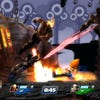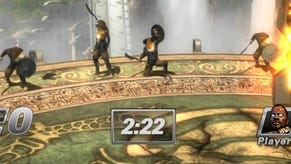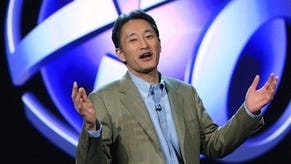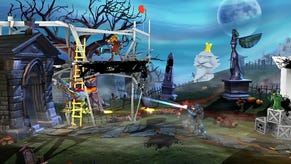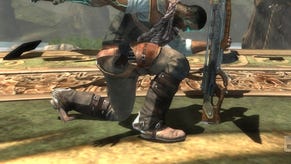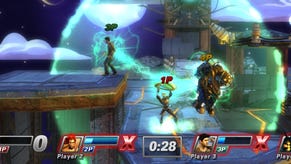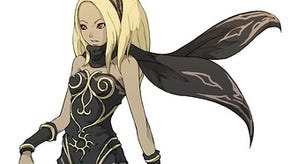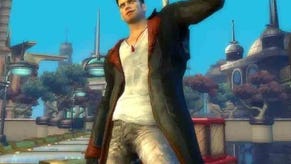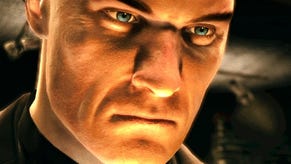Seth Killian's uphill fight with PlayStation All-Stars Battle Royale
Prejudice, tradition and the fighting game community.
“There are some wise people at Santa Monica who had been telling me I should come on board for a long time, well over a year before I had joined,” Seth Killian says, smiling.
“I guess I wasn't ready. I didn't feel like I had done what I came to do at Capcom. I feel very attached to Capcom both personally and professionally. I have a lot of my best friends in the world still there both in the US and Japan. God...”
He turns away, still smiling, but awkwardly. He looks down and, through the lens of his glasses, his eyes betray him. I think, for a second, he may cry.
“... words and letters when I left that I'll treasure forever. Yeah... it's still very difficult for me.”
Seth Killian worked for Capcom USA for six years, banging the fighting game drum as aggressively as he used to play the games themselves in tournaments up and down the country. He travelled the world extolling the virtues of Street Fighter 4 and Marvel vs. Capcom 3 and all that was in-between. He was more than a community manager. He was the link between the fans and the developers we needed. Through him we understood Capcom Japan better. Through him we told Capcom Japan what they were doing wrong and felt that they might just listen.
And then, in June, just after E3, he left the company he loved so much for pastures new at Sony Santa Monica, the gargantuan developer of the God of War and producer of Unfinished Swan, Journey and PlayStation All-Stars Battle Royale.
I remember how shocked I was. Seth and Capcom went hand in hand. Through Yoshinori Ono's revival of Street Fighter Seth's star burned bright. He always had our back. He always understood our problems, our concerns, and he always fed them back. He was part of the furniture at Capcom - reassuring and comfortable.
And that was the problem.
I felt like for years after Capcom being a relatively inaccessible company, to open the doors and finally feel like I was the guy who got on the inside, I really had to do my best

“I had been at Capcom for six years but in my heart I'd been there longer than that,” he says. “It was a huge part of my life. To me it was more than a job. When we didn't do the best job I thought we could have done I wasn't just like, oh well, I didn't do the best job I could have done. I felt like I was letting down my lifelong friends and the whole community.
“I felt like for years after Capcom being a relatively inaccessible company, to open the doors and finally feel like I was the guy who got on the inside, I really had to do my best.”
“DOWN AND CIRCLE! DOWN AND CIRCLE!” someone nearby us screams. We're sitting on a sofa behind a huge TV in 24 Club in London's West End. Sony Computer Entertainment Europe is hosting an event called the PlayStation Access Live Christmas Party and it's packed. Four people are hammering on DualShocks, knocking lumps out of each other on All-Stars and there's a huge crowd watching as they wait their turn to play.
“DOWN TRIANGLE!”
“I felt I had left it in pretty good hands,” Seth continues. “And also, Street Fighter 4, which is really what I came to do, and Marvel, both ended up in places I was pretty pleased with. I'm confident about Capcom's future.
“But for me, I had Ono-san in Japan, I had a direct boss in London and a boss in the US. There was a 24 hour cycle of work as well as a huge amount of travel both for public events and internal development in meetings.”
He sighs and looks down again. “It was just an extreme grind, which, in one way is awesome. It was nice that they wanted me to go to all of these things, and I wanted to always say yes. Maybe I didn't manage my own life as well as I should have, and it caused me to grind down a little bit.”
“OH DEAR! RUN AWAY! RUN AWAY!”
Seth wanted to switch things up and he had an eye on game design, but it would have meant moving to Japan - something he was not prepared to do. So his thoughts turned to Sony and those friends who had turned his head.
“Santa Monica to me is, honestly, one of the best studios in the US. Hands down. To me it's not just that they make quality games. They make a huge range of games. Obviously there's All-Stars, but a lot of what they do is outside of my comfort zone, and I like being in a position to try something new and struggle and potentially fail. I was in a comfortable position at Capcom doing things I was familiar with.”
“YES! DO IT!”
“Street Fighter 4 was my wheelhouse. We've done what we hoped to do. So, going beyond that means getting outside of your comfort zone. Maybe that will be a horrible mistake. But I'm excited about the things they're doing. You've got your God of War on one end, then you've got your Journey and Unfinished Swan on the smaller and more theoretical side. Then you've got games like All-Stars, which are weird and fun and in the middle of games like that.
“I'm also just a big believer in a lot of the people there personally. That's an important thing for me in work. Not just companies or games. It comes down to people. There are organisations, but there's no such thing as an organisation, really. It's just a bunch of people.”
“NOOOOOOOO! AHHH! OKAY!!!” CLAP CLAP CLAP.
“So to work with people I believe in is important to me.”
Between a rock and a hard place
Seth's job title is lead game designer for Santa Monica studio focusing on external development. He jumped straight in at the deep end with PlayStation All-Stars Battle Royale, a game pretty much finished by the time he arrived in June. He spent the next few months getting up to speed on its fighting systems, its many characters, getting a feel for how it moves, how it works, recommending balance changes.
And then travel, and fighting the good fight once again - but this time things are different. This time things are harder, and that's because the fighting game community, Seth's family, are sceptical of the game he's working on.
Many fighting game fans remain unconvinced by All-Stars' credentials. The biggest fighting game websites have threads where fans go back and forth on whether there should be threads on the game in the first place. “You're kidding... A Party game, In a Fighting game website,” says CrossoverFighterRyu93 on EventHubs. “Sorry I thought this was a fighting games site,” says DeadpoolDash, bluntly. Are fighting game fans prejudiced against the game, I wonder?
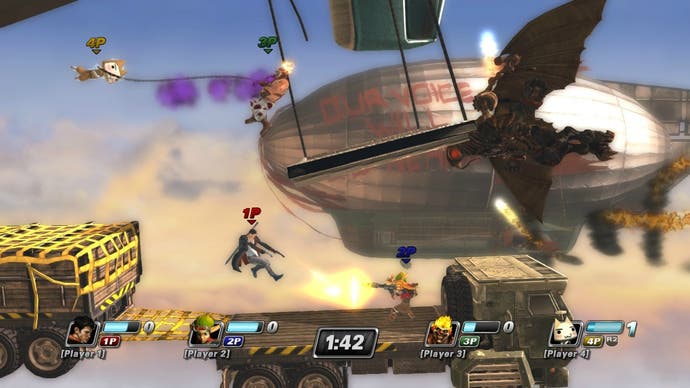
“Of course!” Seth says laughing. “Part of being in the core fighting game community is also about looking hard all of the time, and you're the tough guy. There's a natural conservatism or resistance to the new and to change. That's not just being curmudgeonly, or that people are dumb or don't appreciate new games. It's literally protecting your investment.
“If I'm quite good at Arcade Edition 2012 and Street Fighter 5 comes out and it doesn't play exactly like Street Fighter 4 or it doesn't reward the skills I've built in, I will be thumbs down about it or inherently resistant to it. I have a literal investment. Obviously there's the cost of the game, but there's thousands of hours I've spent practising to be really good at this game and really mastering the details of it.
“So when something comes out that potentially doesn't reward my exact skill set, I'm going to be reticent and resistent to it. It's hard to get past that and appreciate the value of what's new. If a new game comes out and everybody likes it, and they're like, ah yeah, Street Fighter 4, that's the old stuff, no-one cares about that old man! You're like, oh, my investment. It's now worth that much less.
“I don't even think that's wrong for people to act like that, but it's a fact about the fighting game community. Unlike a lot of video games... the new Sly Cooper looks interesting but I doubt it's a game people will play for thousands of hours. It's a game you can care about and have a great time with and get good value out of, but it's not a game you're necessarily going to have a massive level of investment in. So if the new Sly Cooper does something a bit different, it won't destroy you in the same way a fighting game doing something genuinely different is a threat or a risk.
“No question All-Stars is doing a couple of things very different. It's taking a lot of traditional fighting mechanics into a space where they haven't been before.
“It doesn't look tough. It doesn't look badass Japanesey, like, holy cow bro!”
Round one
Is All-Stars a fighting game? The fighting game community isn't sure. Some say it is. Some say it isn't. Seth says it is, “one hundred per cent”. He points to the high-level strategy you need to be successful - the same skills are at play as those you need to win at Street Fighter and other established fighting games. The control of space is there. Mind games are there. Arcade reaction is there. There are wall bounces, crumples, static hit stun, the works.
All-Stars' biggest problem isn't how it looks, although that is a problem. It isn't that it comes off as a Smash Bros. clone, although that's a problem, too (“In some ways I wish it was just a Smash rip-off because people really love Smash, and to have it on a Sony system would be great”) Its biggest problem is that the promotional videos and gameplay footage shown ahead of its release were of party mode, the four-player free-for-all smash 'em up game type that looks about as refined and strategic as a scramble for a cheap phone on Black Friday.
In some ways I wish it was just a Smash rip-off because people really love Smash, and to have it on a Sony system would be great
Sony Santa Monica lead game designer Seth Killian
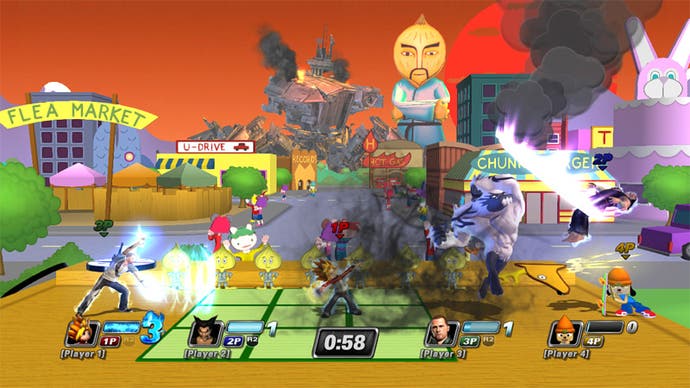
The game's one versus one and two versus two modes have gone almost unnoticed. In these modes, Seth says, fighting game fans will find the deep, strategic fighting game experience every bit as satisfying as what they're used to from the usual suspects.
“The free for all is where it gets a little bit more random and there are elements of variance, which has been one of our struggles, because that's all we show,” he says. “We just show people ping-ponging off each other and it looks random. While somebody's trying to do something serious somebody comes in and snakes him in the back, and that looks like bulls**t and everybody gets upset.
“That's the joy and the sadness of free for all. It's a great mode for people at varying skill levels. Even if you never win you always feel like you got your licks in, unlike a Street Fighter, where if you're really outclassed you know it and you feel it very painfully throughout the whole match.”
The fact that some of the most respected fighting game experts around were involved in All-Stars' creation doesn't matter. Omar Kendall, lead designer, won plaudits for his work on THQ's UFC series. Fighting game combo superstar Maj consulted on the project. Marvel vs. Capcom 2 player Daniel “Clockw0rk” Maniago is SuperBot community manager. And, of course, there's Seth himself. But it doesn't matter. SuperBot has no history. Capcom, the Japanese developer behind Street Fighter, Marvel vs. Capcom and Darkstalkers, has been at this game for over twenty years.
We just show people ping-ponging off each other and it looks random. While somebody's trying to do something serious somebody comes in and snakes him in the back, and that looks like bulls**t and everybody gets upset
Round two
There are combos to be mastered and discovered. Players are doing it right now, and impressive videos are springing up in threads on Shoryuken and other sites. Players are already coming up with their own tricks, set-ups and traps - the technology, to use the fighting game vernacular - and using it online.
But the executional barrier in All-Stars is easier than in other fighting games, and Seth admits it. There's nothing nearly as complicated as the Dragon Punch motion (forward, down, down-forward) in the game. Each move is either a single button press or a button press plus a direction. Instead, the skill is in spacing and mastering directional strength. Characters have been designed to be either directionally able or disabled. Some characters have special moves that make them strong moving down on you from above. Some have special moves that make them strong firing attacks directly above.
“Evil Cole is viscous,” Seth says. “He can catch you from underneath. He can give you a really hard time by shooting up a lot of crap into the air that's hard to avoid. You have to commit early otherwise you're going to get reset or hit several more times. He's very strong against characters that are directly above him.
“Every character has some mix of these abilities. Those things are all true to a certain extent in Street Fighter and Marvel, but it's more important because of the freedom of movement in this game and the relative size of the stage.”
We'll know soon enough whether fighting game experts will take All-Stars seriously. EVO, the biggest and most prestigious fighting game tournament in the world, will soon, once again, be upon us. Will All-Stars be there?
“Ten or fifteen per cent chance,” Seth says. “I'm cynical about the audience, even though those are my people. I hope it is for two reasons. One, because the game is interesting enough and fresh enough to deserve a place there. But that's also not how games are decided at Evo. The decision is also based on which games players want to play. So, it's got to find popular support in terms of the players.
“And two, this game is going to attract an audience that would not play a traditional fighter, or who would be either intimidated or just not interested. Maybe they start out as a fanboy of Ratchet & Clank or something and that's the only reason they pick up All-Stars. But then they discover there's all this stuff under the hood and they get into this game. That will hopefully lead them to fighters. It could be a great injection of new blood into the fighting game scene, which is critical to its continued success.”
Raising this second point, Seth's eyes glisten. “That's part of why I wanted to make a game like All-Stars for many years,” he says, smiling broadly. “It opens the door with a simple control scheme. That's critical to get new people into the door. I would love it if people who played All-Stars played Street Fighter and Marvel. You need a gateway drug.”
Final round
I get the sense that Sony Santa Monica's new lead game designer is revelling in this, his most daunting challenge yet. I've met him many times over the years at Capcom events across the globe. He's always been lovely to talk to and happy to chat at length, but I've seen the work of promoting Capcom's fighting games, the job of being Capcom's buffer, take its toll. Today, in a club in London, he seems buoyant despite knowing those who respect him most respect All-Stars the least.
All-Stars isn't Seth's title, truth be told. He joined Santa Monica as development was winding down. He's happy to bang the All-Stars drum for as long as is necessary, but he's already looking elsewhere. He may even, soon, not be working on a fighting game at all.
“Who knows if there will be an All-Stars 2?” he says. “I'm working on a number of other titles right now that are not announced. Some of them may never become titles. We're in an evaluation period, checking things out and seeing how things are going. But yeah, outside of the fighting game genre."
"AHHH! OKAY!!! CLAP CLAP CLAP."
Was this always the plan, to be a game designer?
“Absolutely not. I've had a few careers in my life. Prior to games I was university teaching, which had nothing to do with games. I was joking that every five years or so I would do something radically different. I don't think game design is radically different to where I was at all, but who knows?
“Maybe I'll do something else. Maybe this won't work out and in a year I'll be doing a game show or something. I'll become a painter. The world's worst painter.”




